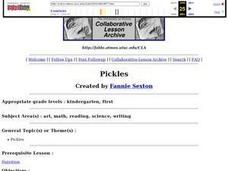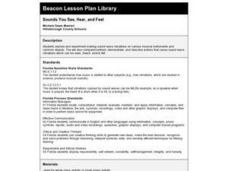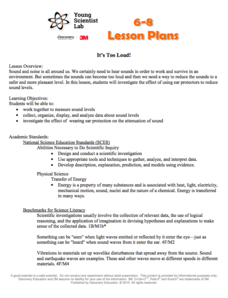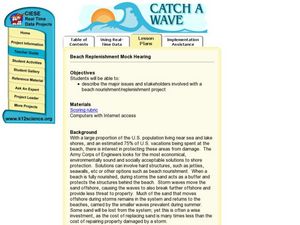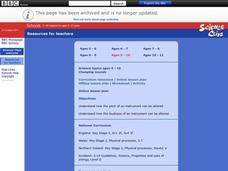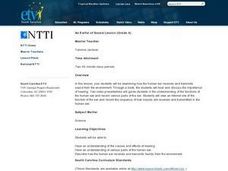Curated OER
Sounds Like Science - Bottle Organ
Students see that by manipulating sound we can arrange a series of notes referred to as a musical scale. They explain the relationship between pitches and notes. They compare the sounds of different-sized bottles.
Curated OER
Changing Sounds
Young scholars identify how the pitch of an instrument can be altered. They complete a worksheet by labeling several images in order of pitch and then fill a bottle with water to create a sound that matches a pitch on a drawn card.
ARKive
Nocturnal Animals
How do those nocturnal animals see in the dark? This perplexing question does have an answer. First, little ones use their sense of touch to determine the name of a mystery object, then they listen closely to identify various animals by...
Curated OER
Pickles
Young learners compare healthy foods to junk foods. They examine the growing process of a vegetable from a seed all the way to maturity. The book, The Magic School Bus in a Pickle is used. Some nice cross-curricular activities in math,...
Curated OER
Sounds Like Science - Guitars
Students discover that all movement produces sound waves but not all sounds can be heard with the human ear. They experiment with a variety of substances to see which are audible and which are inaudible.
Curated OER
Ears and Hearing
Students explore vibrations and sound waves. In this lesson about hearing, students use experiments to determine how sound waves travel. Students use a saucepan, rice, and a plastic cover for one experiment and a tube, plastic wrap, a...
Curated OER
Sounds You See, Hear, and Feel
Young scholars explore and create sound wave vibrations using musical instruments and common objects. They compare/contrast and describe actions that cause sound wave vibrations that can be seen, heard, and felt.
Curated OER
Now Hear This!
Learners observe the differences between low- and high-frequency sounds. They research and compare the characteristics of various animals that rely on infrasonic sounds to communicate.
Discovery Education
It's Too Loud!
STEM scholars investigate sound attenuation by conducting an experiment in which they compare the farthest distance that they can hear a sound with and without ear protection.
Curated OER
Beach Replenishment Mock Hearing
Students study the issues and stakeholders involved in a beach replenishment project. In this beach replenishment lesson, students study the point of views for the various stakeholders in a beach replenishment issue. Students are...
Curated OER
TE Activity: Pitch and Frequency
Students experiment with a vibrating ruler and a kazoo to study the different pitches and frequencies they produce. They create both high and low pitch sound waves. They examine how engineers use sound energy when designing electronic...
Curated OER
Vibrations
Students explore how vibrations create sound by strumming a rubber band. They feel the vibration of their own vocal chords. Then they explore the motion of sound waves and echoes. They rely on their own hearing to locate others in their...
Curated OER
SOUND VIBRATIONS
Student designs a test that uses their sense of hearing to judge the effectiveness of different solids to transmit sound vibrations. Students experience vibrations using several of their senses.
Curated OER
Vibration and Pitch
Fifth graders investigate the relation between vibrations and pitch. They observe and discuss an experiment involving a bicycle and a piece of cardboard in the spokes, listen to a comb with cardboard, and listen to various sounds and...
Curated OER
Wave Action
In this waves worksheet, students compare the characteristics of sound and light waves and determine the wavelength, amplitude, and speed of a wave. This worksheet has 9 problems to solve.
Curated OER
Changing Sounds
Pupils identify how the pitch and the loudness of an instrument can be altered. For this online science of sound lesson, students employ the use of an interactive whiteboard to examine the loudness and pitch of a guitar, drum, and bottle...
Curated OER
Radio Waves
In this radio waves learning exercise, learners read about how broadcasting uses radio waves to deliver sound and how radio signals are received. Then students complete 3 short answer questions.
Curated OER
Pitch
Students experience sounds with different pitches. In this pitch lesson, students use open pipes as they are introduced to pitch, then make Straw Pan Pipes.
Acoustical Society of America
Musical Instruments
Mix it up and engage learners in a lesson on music and physical science. Using cups, strings, guitars, and voice, the class will experiment with sound vibration and frequency. They'll use each instrument and fill out a worksheet that...
Acoustical Society of America
Musical Instruments Part I - Woodwinds
What is the connection between sound and vibration? Learners find out as they conduct a series of experiments with instruments they create. The experiment is well explained, includes modifications for visuall and hearing impaired...
University of Colorado
The Jovian Basketball Hoop
A radio receives radio signals, converts them to an electrical signal, then converts this signal to a sound signal, and amplifies the sound so people can hear it. Class members use this information to create a short-wave radio antenna...
Texas State Energy Conservation Office
Investigation: Waves and Whistles
Wave goodbye to the same old demonstrations for alternative energy sources, and wave hello to this one investigating ocean waves! Using a water bottle to create an oscillating water column, learners see and possibly hear how the...
Curated OER
An Earful of Sound Lesson
Fourth graders examine how the human ear receives and transmits sound from the environment. Through a book, they hear and discuss the importance of hearing. Students view an Internet site of the function of the ear and record the...
Curated OER
How The Ear Receives Sound
In this how the ear receives sound worksheet, students examine and follow a flow chart to view the process of how sound travels within the human ear. Students place the flow chart in chronological order.





